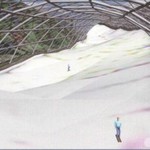 Switzerland's ski industry is contemplating opening the country's first indoor ski area to encourage more young people living in urban areas to take up the sport.
Switzerland's ski industry is contemplating opening the country's first indoor ski area to encourage more young people living in urban areas to take up the sport.According to the Swiss association of mountain lift companies, the number of youngsters who know how to ski or snowboard is decreasing by about ten per cent a year.
Plans are for an artificial indoor ski slope measuring 300 metres in length, with a gradient of about 30 degrees. Its dimensions pale in comparison with even the most modest downhill run in the smallest of alpine resorts.
But the idea, according to Felix Maurhofer of the Swiss association of mountain lift companies, is not to compete with existing ski areas.
"Indoor ski centres can play an important role by introducing a new generation to winter sports," Maurhofer told swissinfo shortly after returning from a field trip to Germany where representatives of the Swiss ski industry visited three facilities.
Locals account for around 60 per cent of all skiers at Switzerland's resorts, but Maurhofer says the average age of skiers is rising since fewer young Swiss are taking up the sport.
"We'll have a real problem in ten years' time if we don't attract a new generation.
"Indoor ski halls guarantee snow and make it easy for people to get their first taste of winter sports. We have to provide young people with an alternative when there is no snow in low-lying ski areas [close to the towns and cities where they live]."
His view is echoed by Tanja Behnke of the Jever Skihalle outside the German city of Düsseldorf – Germany's first such facility when it opened six years ago.
About 100,000 people learn how to ski or snowboard here every year.
Paving the way
The indoor sports centre has more than a million paying customers each year. "We prepare people for the mountains and winter sports - for their holidays," Behnke told swissinfo.
"About 100,000 people learn how to ski or snowboard here every year, and maybe they would never have taken up the sport if it wasn't for the ski hall."
Behnke stresses that finding the right mix has been the key to the indoor facility's success. Besides skiing, the Jever centre has an indoor climbing wall, play area for children and restaurants including a beer garden. It also organises regular parties and concerts.
While skiing is the main drawing card, the side attractions and events generate the lion's share of revenues.
The plan for Switzerland's first indoor ski facility is being spearheaded by Zermatt's ski lift company. The next step, according to Maurhofer, is to carry out a feasibility study and to find a suitable location for a centre that could cost around SFr70 million ($56 million).
However, some ski industry officials quoted in the Swiss press say the money would be better spent promoting the country's ski resorts to the captive audience that frequents Germany's indoor centres.
But Austrian ski regions have a virtual advertising monopoly at places like Jever, which goes as far as hiring Austrian ski instructors and serving Austrian cuisine.
Maurhofer admits that Switzerland has missed the boat. "The Swiss tourist industry didn't think the centres would be as successful as they are, and now it's very difficult for us to get our foot in the door to do any marketing or sales."



